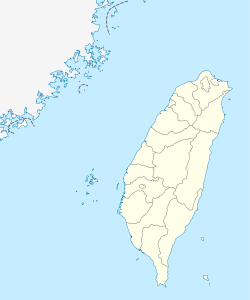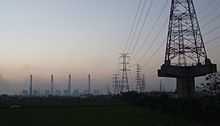Taichung Power Plant
| Taichung Power Plant 台中發電廠 | |
|---|---|
 | |
 台中發電廠 | |
| Country | Republic of China |
| Location | Longjing District, Taichung City |
| Coordinates | 24°12′46″N 120°28′52″E / 24.21278°N 120.48111°ECoordinates: 24°12′46″N 120°28′52″E / 24.21278°N 120.48111°E |
| Status | Operational |
| Commission date |
1992 (Unit 1-4) 1996-1997 (Unit 5-8) June 2005 (Unit 9) June 2006 (Unit 10)[1] |
| Owner(s) | Taipower |
| Operator(s) | Taipower |
| Constructor(s) |
Gilbert Engineers BES Engineering |
| Power station | |
| Primary fuel | Bituminous coal |
| Generation units |
10 X 550 MW (coal) 4 X 70 MW (natural gas) 22 X 2 MW (wind power) |
| Turbine manufacturer(s) |
General Electric Toshiba |
| Power generation | |
| Installed capacity | 5,824 MW |
| Annual generation | 42,000 GW·h |
The Taichung Power Plant (Chinese: 台中發電廠; pinyin: Táizhōng Fādiànchǎng) is a coal-fired power plant in Longjing, Taichung, Taiwan. With an installed coal-fired generation capacity of 5,500 MW, it is the largest coal-fired power station in the world,[2][3] and also the world's largest emitter of carbon dioxide with approximately 40 million tons annually (or about as much as the country of Switzerland as a whole).[4] Together with its gas-fired and wind generation units, the total installed capacity of the plant is 5,824 MW.
Generation units
The power plant consists of ten coal-fired units with nominal capacity of 550 MW each. Four original units were commissioned in 1992. In 1996–1997, four additional units were added. The eight older units have a total estimated coal requirement of around 12 million tonnes of bituminous and 2.5 million tonnes of sub-bituminous coal a year. In June 2005 and June 2006, 550 MW sub-critical pressure units 9 and 10 were installed.[3]
In addition to ten coal-fired steam turbines, Taichung Power Plant has another four gas turbines and twenty two wind turbines which add another 288 MW and 44 MW additional capacity respectively.[5]
Components
The boiler for each unit is drum type, water-cooled, naturally circulated with dry bottom furnace, balance draft and coal and oil-fired capability.
The steam turbine for each unit is a tandem-compound with four flow exhaust, single reheat and 550 MW rated capacity.
The electrostatic precipitator removes 99.8% of the particulates and classifies them for industrial cement and land reclamation.[6]
The plant has four coal conveyor belts. Two belts are from the coal harbor terminal to the transfer tower, and another two is from the transfer tower to the generation units of the power plants. All of the belts are equipped with fire detection system to monitor the temperature along the belt and to send alarm in the case of fire to minimize damage.[7]
Function
The power plant is designed for base load service and is able for daily startup and shutdown operation.[6] The plant's electricity is being sold to Taipower under a 25-year power purchase agreement.[8]

Fuel supply
The power plant uses 12 million tons of bituminous and 2.5 million tons of sub-bituminous coal a year. Taipower buys 70% of the plant coal supply through long-term contracts from Australia, United States, South Africa, Indonesia and other sources. Indonesia is the prime source for the sub-bituminous coal. The remaining 30% of its coal supply is purchased on the spot market.[8]
Future expansion
There is an expansion plan to build two new 800 MW units by 2016.[1][9]
Transportation
Taichung Power Plant is accessible West from Longjing Station of the Taiwan Railway Administration.
See also
- List of power stations in Taiwan
- Hai-Fu Power Station
- List of coal power stations
- List of largest power stations in the world
References
- ↑ 1.0 1.1 http://morganenergysol.com/energy-updates/taichung-power-plant-worlds-largest-coal-fired-power-plant/
- ↑ Taipower (2008). 2008 Sustainability Reports – Power Generation And Transmission (PDF). p. 3. Retrieved 2009-07-10.
- ↑ 3.0 3.1 "Taichung Coal-Fired Power Plant, Taiwan". power-technology.com. Net Resources International. Retrieved 2009-07-10.
- ↑ "Taichung". CARMA - Carbon Monitoring for Action. Retrieved 2009-07-10.
- ↑ http://www.brain-c-jcoal.info/news_images/JapanTaiwanCCTWorkshop2009_05.pdf
- ↑ 6.0 6.1 http://www.gibsin.com.tw/old/Case-Taichung1-10FPP.pdf
- ↑ http://www.lios-tech.com/Menu/DE.TECT/Case+Studies/Fire+Detection+for+the+Coal+Conveyer+Belt+System+at+Taichung+Power+Plant,+Taiwan
- ↑ 8.0 8.1 http://www.power-technology.com/projects/taichung/
- ↑ http://www.industcards.com/st-coal-taiwan.htm